Assessing Value Management and Sustainability in Construction Report
VerifiedAdded on 2023/01/12
|13
|3949
|84
Report
AI Summary
This report provides a comprehensive overview of value management within the construction industry. It begins by exploring the factors that ensure sustainability impacts during the construction process, including economic, social, and environmental considerations. The report then delves into the value management process, outlining its core elements and stages, such as value planning, value engineering, and value reviewing. It further examines various methods of innovation and creativity that can enhance efficiency and productivity, including self-repairing concrete, new materials, construction drones, and smart headsets. The report also discusses two standard value management tools and risk management strategies. It identifies factors contributing to poor project value, and concludes with a summary of key findings and recommendations.
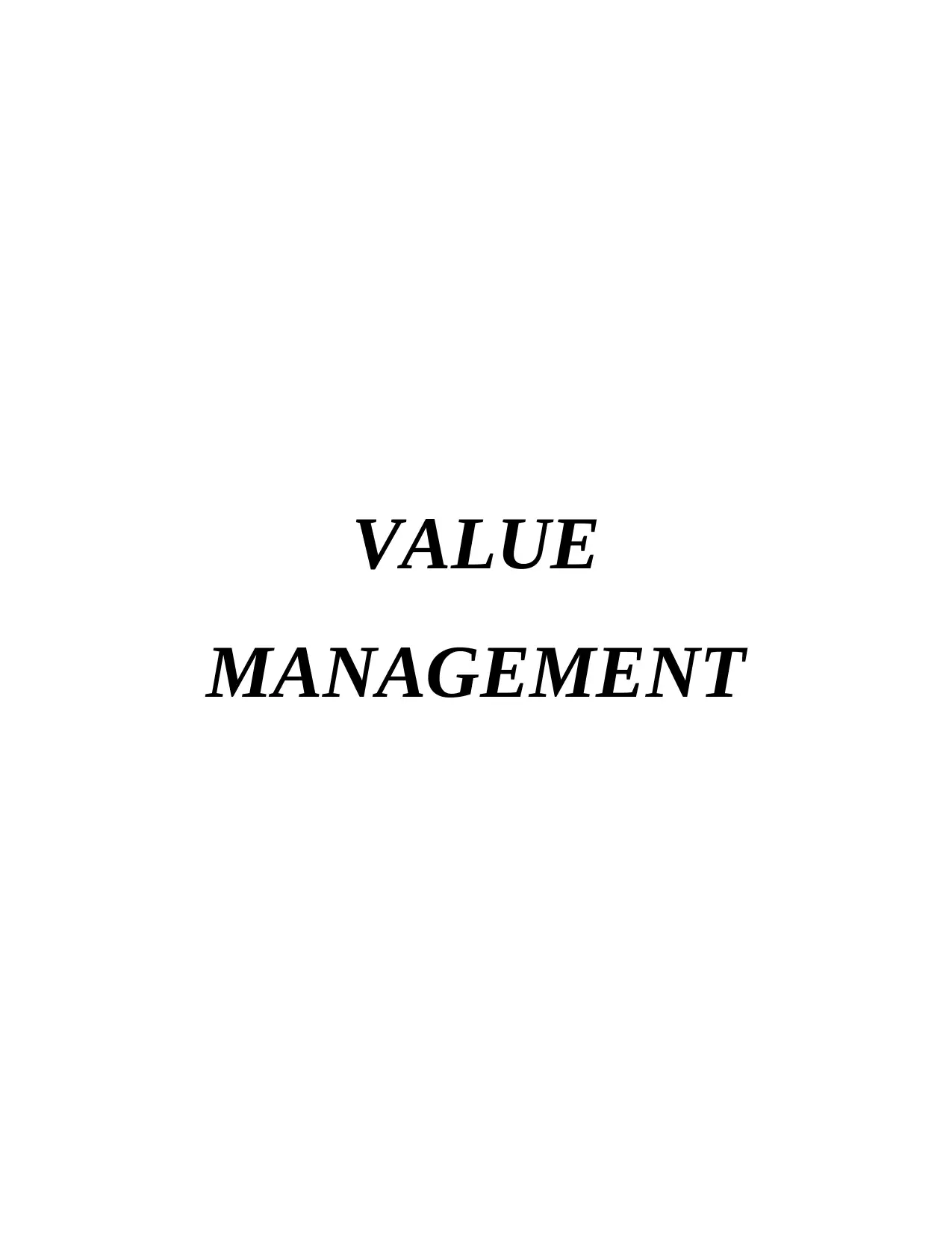
VALUE
MANAGEMENT
MANAGEMENT
Paraphrase This Document
Need a fresh take? Get an instant paraphrase of this document with our AI Paraphraser
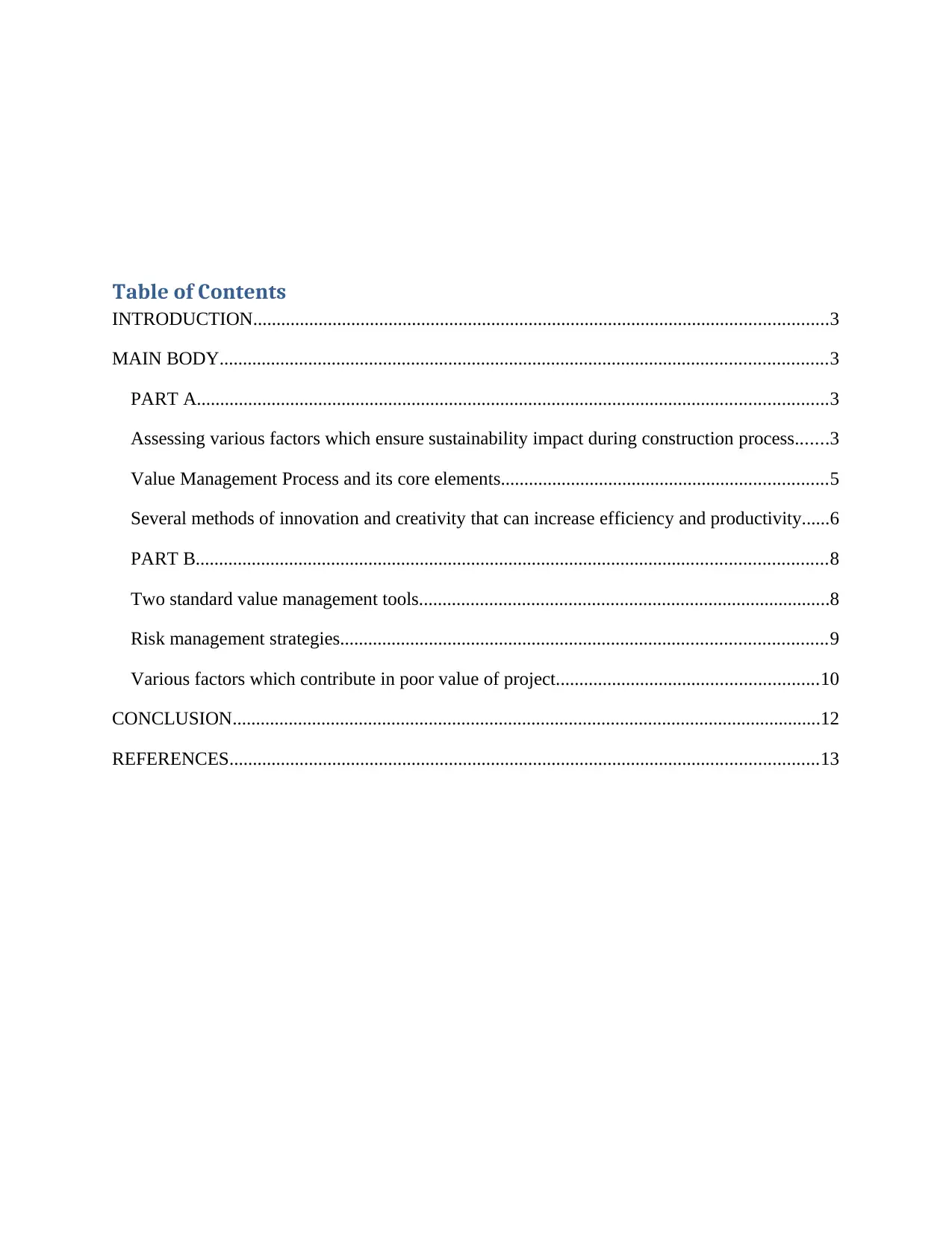
Table of Contents
INTRODUCTION...........................................................................................................................3
MAIN BODY..................................................................................................................................3
PART A.......................................................................................................................................3
Assessing various factors which ensure sustainability impact during construction process.......3
Value Management Process and its core elements......................................................................5
Several methods of innovation and creativity that can increase efficiency and productivity......6
PART B.......................................................................................................................................8
Two standard value management tools........................................................................................8
Risk management strategies........................................................................................................9
Various factors which contribute in poor value of project........................................................10
CONCLUSION..............................................................................................................................12
REFERENCES..............................................................................................................................13
INTRODUCTION...........................................................................................................................3
MAIN BODY..................................................................................................................................3
PART A.......................................................................................................................................3
Assessing various factors which ensure sustainability impact during construction process.......3
Value Management Process and its core elements......................................................................5
Several methods of innovation and creativity that can increase efficiency and productivity......6
PART B.......................................................................................................................................8
Two standard value management tools........................................................................................8
Risk management strategies........................................................................................................9
Various factors which contribute in poor value of project........................................................10
CONCLUSION..............................................................................................................................12
REFERENCES..............................................................................................................................13
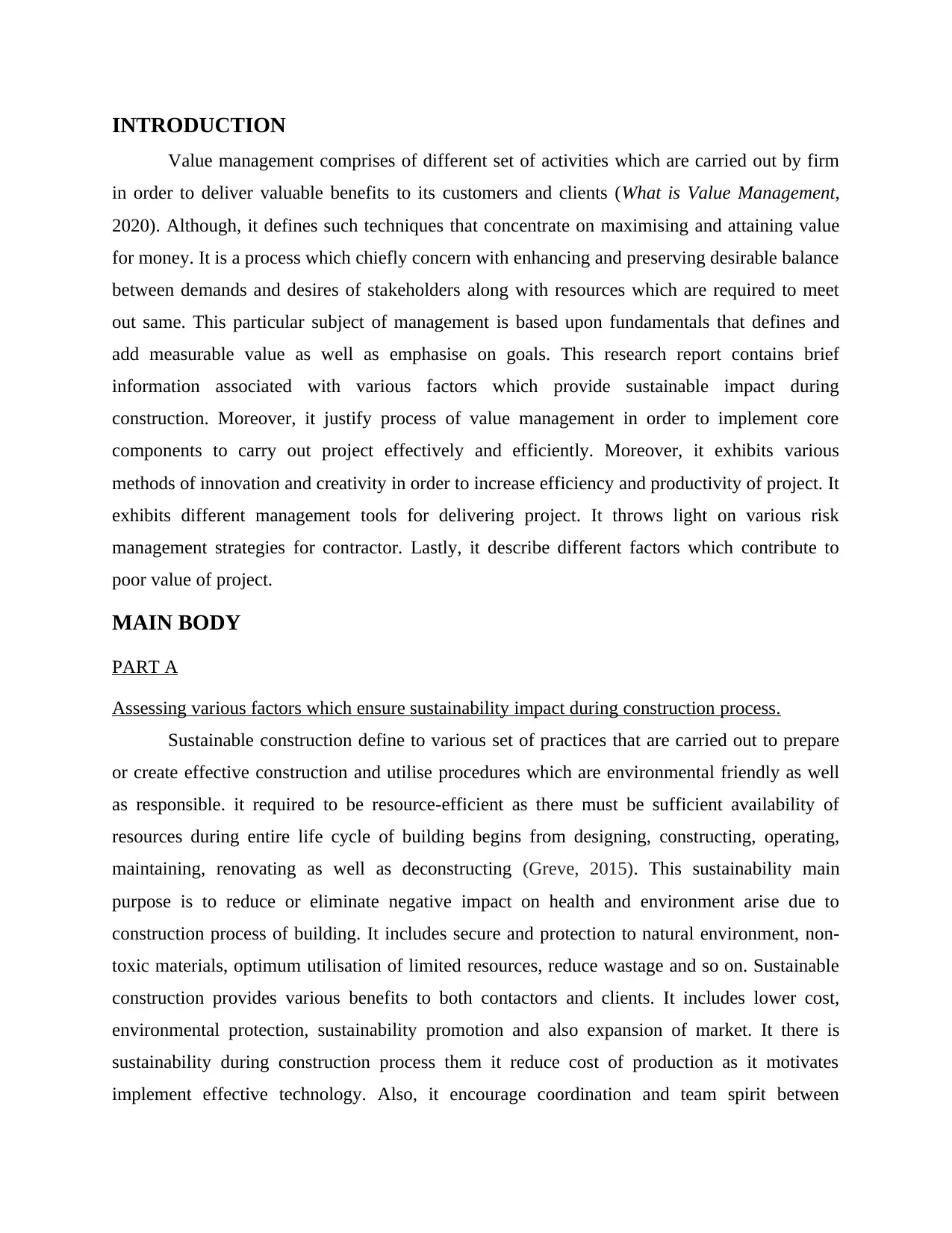
INTRODUCTION
Value management comprises of different set of activities which are carried out by firm
in order to deliver valuable benefits to its customers and clients (What is Value Management,
2020). Although, it defines such techniques that concentrate on maximising and attaining value
for money. It is a process which chiefly concern with enhancing and preserving desirable balance
between demands and desires of stakeholders along with resources which are required to meet
out same. This particular subject of management is based upon fundamentals that defines and
add measurable value as well as emphasise on goals. This research report contains brief
information associated with various factors which provide sustainable impact during
construction. Moreover, it justify process of value management in order to implement core
components to carry out project effectively and efficiently. Moreover, it exhibits various
methods of innovation and creativity in order to increase efficiency and productivity of project. It
exhibits different management tools for delivering project. It throws light on various risk
management strategies for contractor. Lastly, it describe different factors which contribute to
poor value of project.
MAIN BODY
PART A
Assessing various factors which ensure sustainability impact during construction process.
Sustainable construction define to various set of practices that are carried out to prepare
or create effective construction and utilise procedures which are environmental friendly as well
as responsible. it required to be resource-efficient as there must be sufficient availability of
resources during entire life cycle of building begins from designing, constructing, operating,
maintaining, renovating as well as deconstructing (Greve, 2015). This sustainability main
purpose is to reduce or eliminate negative impact on health and environment arise due to
construction process of building. It includes secure and protection to natural environment, non-
toxic materials, optimum utilisation of limited resources, reduce wastage and so on. Sustainable
construction provides various benefits to both contactors and clients. It includes lower cost,
environmental protection, sustainability promotion and also expansion of market. It there is
sustainability during construction process them it reduce cost of production as it motivates
implement effective technology. Also, it encourage coordination and team spirit between
Value management comprises of different set of activities which are carried out by firm
in order to deliver valuable benefits to its customers and clients (What is Value Management,
2020). Although, it defines such techniques that concentrate on maximising and attaining value
for money. It is a process which chiefly concern with enhancing and preserving desirable balance
between demands and desires of stakeholders along with resources which are required to meet
out same. This particular subject of management is based upon fundamentals that defines and
add measurable value as well as emphasise on goals. This research report contains brief
information associated with various factors which provide sustainable impact during
construction. Moreover, it justify process of value management in order to implement core
components to carry out project effectively and efficiently. Moreover, it exhibits various
methods of innovation and creativity in order to increase efficiency and productivity of project. It
exhibits different management tools for delivering project. It throws light on various risk
management strategies for contractor. Lastly, it describe different factors which contribute to
poor value of project.
MAIN BODY
PART A
Assessing various factors which ensure sustainability impact during construction process.
Sustainable construction define to various set of practices that are carried out to prepare
or create effective construction and utilise procedures which are environmental friendly as well
as responsible. it required to be resource-efficient as there must be sufficient availability of
resources during entire life cycle of building begins from designing, constructing, operating,
maintaining, renovating as well as deconstructing (Greve, 2015). This sustainability main
purpose is to reduce or eliminate negative impact on health and environment arise due to
construction process of building. It includes secure and protection to natural environment, non-
toxic materials, optimum utilisation of limited resources, reduce wastage and so on. Sustainable
construction provides various benefits to both contactors and clients. It includes lower cost,
environmental protection, sustainability promotion and also expansion of market. It there is
sustainability during construction process them it reduce cost of production as it motivates
implement effective technology. Also, it encourage coordination and team spirit between
⊘ This is a preview!⊘
Do you want full access?
Subscribe today to unlock all pages.

Trusted by 1+ million students worldwide
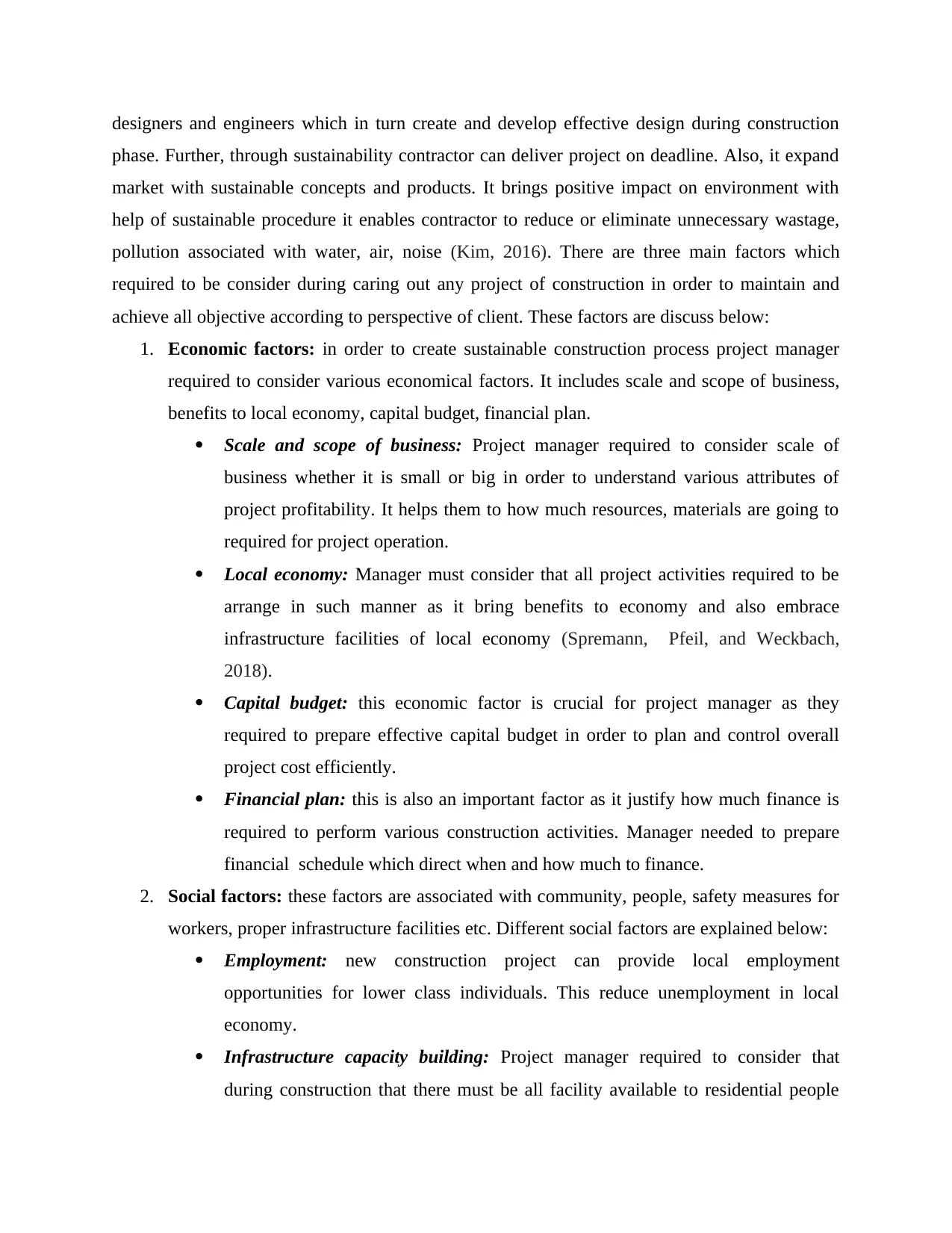
designers and engineers which in turn create and develop effective design during construction
phase. Further, through sustainability contractor can deliver project on deadline. Also, it expand
market with sustainable concepts and products. It brings positive impact on environment with
help of sustainable procedure it enables contractor to reduce or eliminate unnecessary wastage,
pollution associated with water, air, noise (Kim, 2016). There are three main factors which
required to be consider during caring out any project of construction in order to maintain and
achieve all objective according to perspective of client. These factors are discuss below:
1. Economic factors: in order to create sustainable construction process project manager
required to consider various economical factors. It includes scale and scope of business,
benefits to local economy, capital budget, financial plan.
Scale and scope of business: Project manager required to consider scale of
business whether it is small or big in order to understand various attributes of
project profitability. It helps them to how much resources, materials are going to
required for project operation.
Local economy: Manager must consider that all project activities required to be
arrange in such manner as it bring benefits to economy and also embrace
infrastructure facilities of local economy (Spremann, Pfeil, and Weckbach,
2018).
Capital budget: this economic factor is crucial for project manager as they
required to prepare effective capital budget in order to plan and control overall
project cost efficiently.
Financial plan: this is also an important factor as it justify how much finance is
required to perform various construction activities. Manager needed to prepare
financial schedule which direct when and how much to finance.
2. Social factors: these factors are associated with community, people, safety measures for
workers, proper infrastructure facilities etc. Different social factors are explained below:
Employment: new construction project can provide local employment
opportunities for lower class individuals. This reduce unemployment in local
economy.
Infrastructure capacity building: Project manager required to consider that
during construction that there must be all facility available to residential people
phase. Further, through sustainability contractor can deliver project on deadline. Also, it expand
market with sustainable concepts and products. It brings positive impact on environment with
help of sustainable procedure it enables contractor to reduce or eliminate unnecessary wastage,
pollution associated with water, air, noise (Kim, 2016). There are three main factors which
required to be consider during caring out any project of construction in order to maintain and
achieve all objective according to perspective of client. These factors are discuss below:
1. Economic factors: in order to create sustainable construction process project manager
required to consider various economical factors. It includes scale and scope of business,
benefits to local economy, capital budget, financial plan.
Scale and scope of business: Project manager required to consider scale of
business whether it is small or big in order to understand various attributes of
project profitability. It helps them to how much resources, materials are going to
required for project operation.
Local economy: Manager must consider that all project activities required to be
arrange in such manner as it bring benefits to economy and also embrace
infrastructure facilities of local economy (Spremann, Pfeil, and Weckbach,
2018).
Capital budget: this economic factor is crucial for project manager as they
required to prepare effective capital budget in order to plan and control overall
project cost efficiently.
Financial plan: this is also an important factor as it justify how much finance is
required to perform various construction activities. Manager needed to prepare
financial schedule which direct when and how much to finance.
2. Social factors: these factors are associated with community, people, safety measures for
workers, proper infrastructure facilities etc. Different social factors are explained below:
Employment: new construction project can provide local employment
opportunities for lower class individuals. This reduce unemployment in local
economy.
Infrastructure capacity building: Project manager required to consider that
during construction that there must be all facility available to residential people
Paraphrase This Document
Need a fresh take? Get an instant paraphrase of this document with our AI Paraphraser
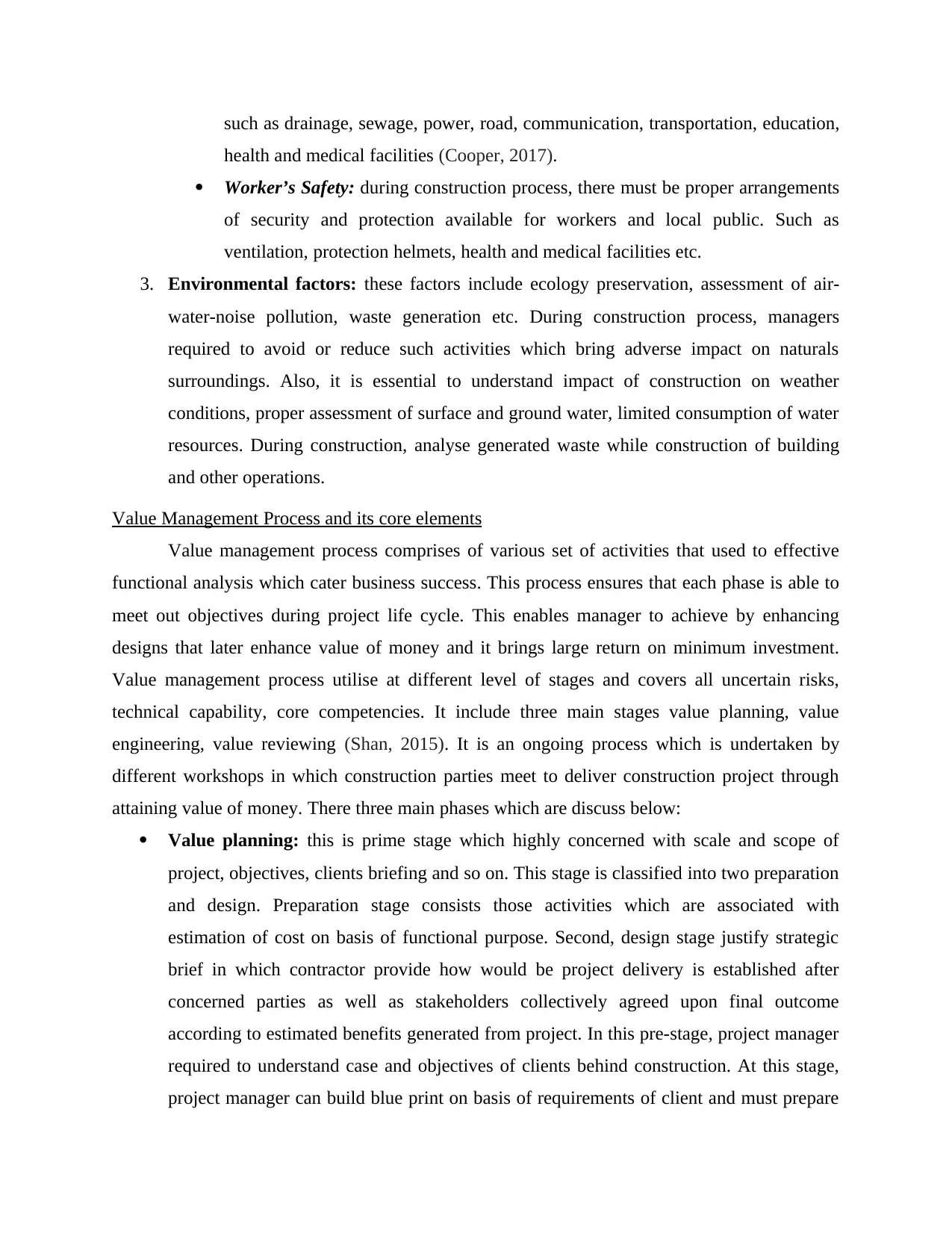
such as drainage, sewage, power, road, communication, transportation, education,
health and medical facilities (Cooper, 2017).
Worker’s Safety: during construction process, there must be proper arrangements
of security and protection available for workers and local public. Such as
ventilation, protection helmets, health and medical facilities etc.
3. Environmental factors: these factors include ecology preservation, assessment of air-
water-noise pollution, waste generation etc. During construction process, managers
required to avoid or reduce such activities which bring adverse impact on naturals
surroundings. Also, it is essential to understand impact of construction on weather
conditions, proper assessment of surface and ground water, limited consumption of water
resources. During construction, analyse generated waste while construction of building
and other operations.
Value Management Process and its core elements
Value management process comprises of various set of activities that used to effective
functional analysis which cater business success. This process ensures that each phase is able to
meet out objectives during project life cycle. This enables manager to achieve by enhancing
designs that later enhance value of money and it brings large return on minimum investment.
Value management process utilise at different level of stages and covers all uncertain risks,
technical capability, core competencies. It include three main stages value planning, value
engineering, value reviewing (Shan, 2015). It is an ongoing process which is undertaken by
different workshops in which construction parties meet to deliver construction project through
attaining value of money. There three main phases which are discuss below:
Value planning: this is prime stage which highly concerned with scale and scope of
project, objectives, clients briefing and so on. This stage is classified into two preparation
and design. Preparation stage consists those activities which are associated with
estimation of cost on basis of functional purpose. Second, design stage justify strategic
brief in which contractor provide how would be project delivery is established after
concerned parties as well as stakeholders collectively agreed upon final outcome
according to estimated benefits generated from project. In this pre-stage, project manager
required to understand case and objectives of clients behind construction. At this stage,
project manager can build blue print on basis of requirements of client and must prepare
health and medical facilities (Cooper, 2017).
Worker’s Safety: during construction process, there must be proper arrangements
of security and protection available for workers and local public. Such as
ventilation, protection helmets, health and medical facilities etc.
3. Environmental factors: these factors include ecology preservation, assessment of air-
water-noise pollution, waste generation etc. During construction process, managers
required to avoid or reduce such activities which bring adverse impact on naturals
surroundings. Also, it is essential to understand impact of construction on weather
conditions, proper assessment of surface and ground water, limited consumption of water
resources. During construction, analyse generated waste while construction of building
and other operations.
Value Management Process and its core elements
Value management process comprises of various set of activities that used to effective
functional analysis which cater business success. This process ensures that each phase is able to
meet out objectives during project life cycle. This enables manager to achieve by enhancing
designs that later enhance value of money and it brings large return on minimum investment.
Value management process utilise at different level of stages and covers all uncertain risks,
technical capability, core competencies. It include three main stages value planning, value
engineering, value reviewing (Shan, 2015). It is an ongoing process which is undertaken by
different workshops in which construction parties meet to deliver construction project through
attaining value of money. There three main phases which are discuss below:
Value planning: this is prime stage which highly concerned with scale and scope of
project, objectives, clients briefing and so on. This stage is classified into two preparation
and design. Preparation stage consists those activities which are associated with
estimation of cost on basis of functional purpose. Second, design stage justify strategic
brief in which contractor provide how would be project delivery is established after
concerned parties as well as stakeholders collectively agreed upon final outcome
according to estimated benefits generated from project. In this pre-stage, project manager
required to understand case and objectives of clients behind construction. At this stage,
project manager can build blue print on basis of requirements of client and must prepare
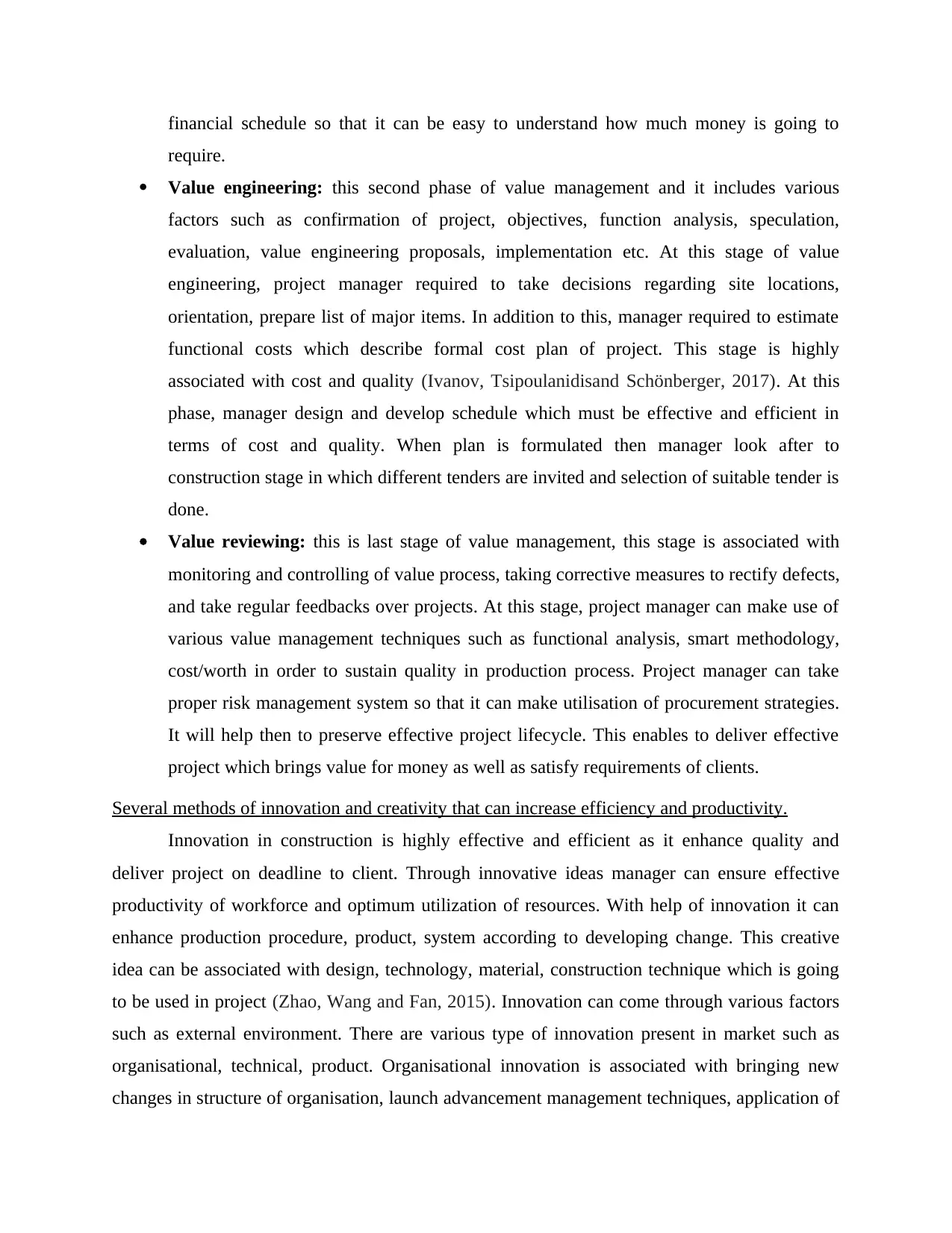
financial schedule so that it can be easy to understand how much money is going to
require.
Value engineering: this second phase of value management and it includes various
factors such as confirmation of project, objectives, function analysis, speculation,
evaluation, value engineering proposals, implementation etc. At this stage of value
engineering, project manager required to take decisions regarding site locations,
orientation, prepare list of major items. In addition to this, manager required to estimate
functional costs which describe formal cost plan of project. This stage is highly
associated with cost and quality (Ivanov, Tsipoulanidisand Schönberger, 2017). At this
phase, manager design and develop schedule which must be effective and efficient in
terms of cost and quality. When plan is formulated then manager look after to
construction stage in which different tenders are invited and selection of suitable tender is
done.
Value reviewing: this is last stage of value management, this stage is associated with
monitoring and controlling of value process, taking corrective measures to rectify defects,
and take regular feedbacks over projects. At this stage, project manager can make use of
various value management techniques such as functional analysis, smart methodology,
cost/worth in order to sustain quality in production process. Project manager can take
proper risk management system so that it can make utilisation of procurement strategies.
It will help then to preserve effective project lifecycle. This enables to deliver effective
project which brings value for money as well as satisfy requirements of clients.
Several methods of innovation and creativity that can increase efficiency and productivity.
Innovation in construction is highly effective and efficient as it enhance quality and
deliver project on deadline to client. Through innovative ideas manager can ensure effective
productivity of workforce and optimum utilization of resources. With help of innovation it can
enhance production procedure, product, system according to developing change. This creative
idea can be associated with design, technology, material, construction technique which is going
to be used in project (Zhao, Wang and Fan, 2015). Innovation can come through various factors
such as external environment. There are various type of innovation present in market such as
organisational, technical, product. Organisational innovation is associated with bringing new
changes in structure of organisation, launch advancement management techniques, application of
require.
Value engineering: this second phase of value management and it includes various
factors such as confirmation of project, objectives, function analysis, speculation,
evaluation, value engineering proposals, implementation etc. At this stage of value
engineering, project manager required to take decisions regarding site locations,
orientation, prepare list of major items. In addition to this, manager required to estimate
functional costs which describe formal cost plan of project. This stage is highly
associated with cost and quality (Ivanov, Tsipoulanidisand Schönberger, 2017). At this
phase, manager design and develop schedule which must be effective and efficient in
terms of cost and quality. When plan is formulated then manager look after to
construction stage in which different tenders are invited and selection of suitable tender is
done.
Value reviewing: this is last stage of value management, this stage is associated with
monitoring and controlling of value process, taking corrective measures to rectify defects,
and take regular feedbacks over projects. At this stage, project manager can make use of
various value management techniques such as functional analysis, smart methodology,
cost/worth in order to sustain quality in production process. Project manager can take
proper risk management system so that it can make utilisation of procurement strategies.
It will help then to preserve effective project lifecycle. This enables to deliver effective
project which brings value for money as well as satisfy requirements of clients.
Several methods of innovation and creativity that can increase efficiency and productivity.
Innovation in construction is highly effective and efficient as it enhance quality and
deliver project on deadline to client. Through innovative ideas manager can ensure effective
productivity of workforce and optimum utilization of resources. With help of innovation it can
enhance production procedure, product, system according to developing change. This creative
idea can be associated with design, technology, material, construction technique which is going
to be used in project (Zhao, Wang and Fan, 2015). Innovation can come through various factors
such as external environment. There are various type of innovation present in market such as
organisational, technical, product. Organisational innovation is associated with bringing new
changes in structure of organisation, launch advancement management techniques, application of
⊘ This is a preview!⊘
Do you want full access?
Subscribe today to unlock all pages.

Trusted by 1+ million students worldwide
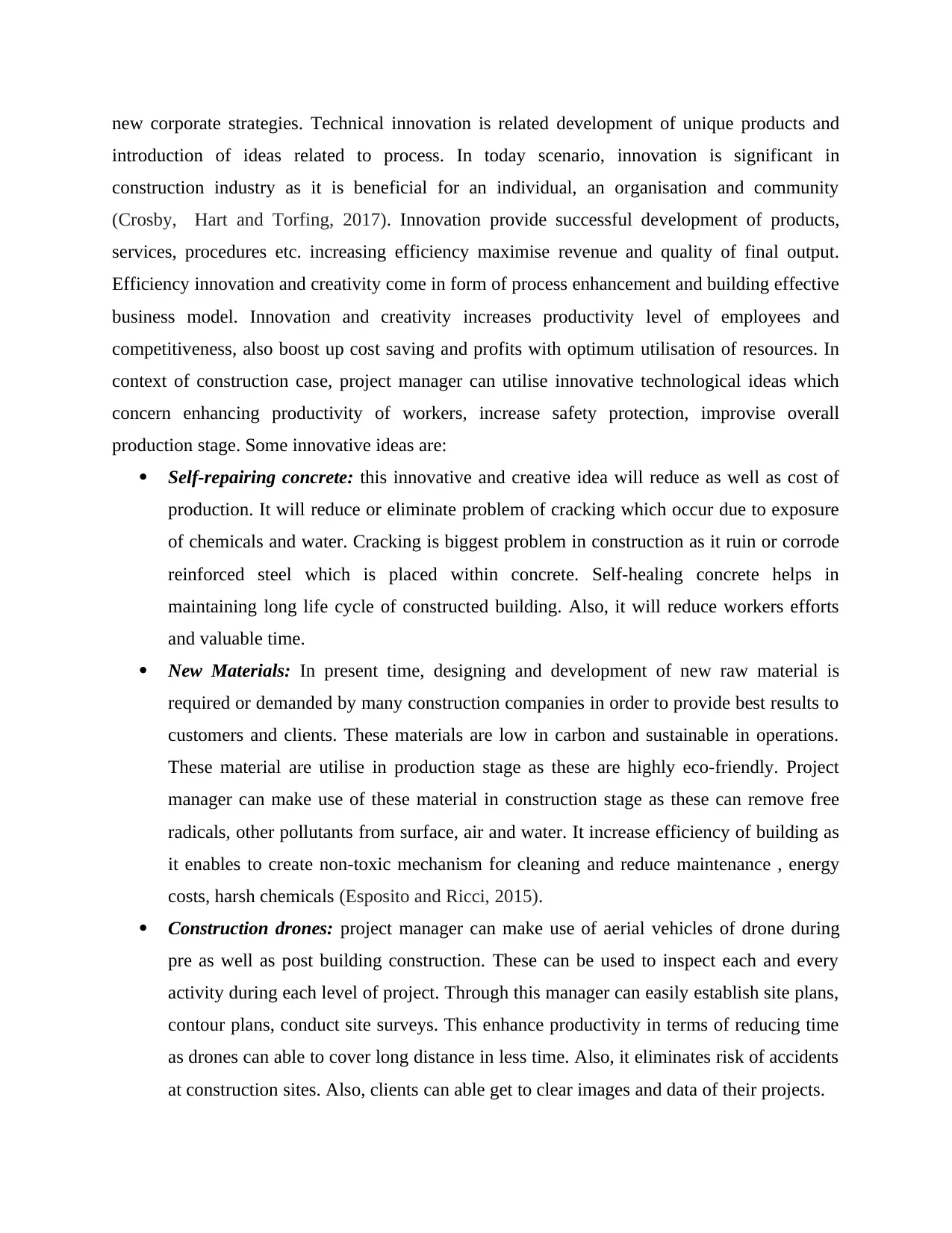
new corporate strategies. Technical innovation is related development of unique products and
introduction of ideas related to process. In today scenario, innovation is significant in
construction industry as it is beneficial for an individual, an organisation and community
(Crosby, Hart and Torfing, 2017). Innovation provide successful development of products,
services, procedures etc. increasing efficiency maximise revenue and quality of final output.
Efficiency innovation and creativity come in form of process enhancement and building effective
business model. Innovation and creativity increases productivity level of employees and
competitiveness, also boost up cost saving and profits with optimum utilisation of resources. In
context of construction case, project manager can utilise innovative technological ideas which
concern enhancing productivity of workers, increase safety protection, improvise overall
production stage. Some innovative ideas are:
Self-repairing concrete: this innovative and creative idea will reduce as well as cost of
production. It will reduce or eliminate problem of cracking which occur due to exposure
of chemicals and water. Cracking is biggest problem in construction as it ruin or corrode
reinforced steel which is placed within concrete. Self-healing concrete helps in
maintaining long life cycle of constructed building. Also, it will reduce workers efforts
and valuable time.
New Materials: In present time, designing and development of new raw material is
required or demanded by many construction companies in order to provide best results to
customers and clients. These materials are low in carbon and sustainable in operations.
These material are utilise in production stage as these are highly eco-friendly. Project
manager can make use of these material in construction stage as these can remove free
radicals, other pollutants from surface, air and water. It increase efficiency of building as
it enables to create non-toxic mechanism for cleaning and reduce maintenance , energy
costs, harsh chemicals (Esposito and Ricci, 2015).
Construction drones: project manager can make use of aerial vehicles of drone during
pre as well as post building construction. These can be used to inspect each and every
activity during each level of project. Through this manager can easily establish site plans,
contour plans, conduct site surveys. This enhance productivity in terms of reducing time
as drones can able to cover long distance in less time. Also, it eliminates risk of accidents
at construction sites. Also, clients can able get to clear images and data of their projects.
introduction of ideas related to process. In today scenario, innovation is significant in
construction industry as it is beneficial for an individual, an organisation and community
(Crosby, Hart and Torfing, 2017). Innovation provide successful development of products,
services, procedures etc. increasing efficiency maximise revenue and quality of final output.
Efficiency innovation and creativity come in form of process enhancement and building effective
business model. Innovation and creativity increases productivity level of employees and
competitiveness, also boost up cost saving and profits with optimum utilisation of resources. In
context of construction case, project manager can utilise innovative technological ideas which
concern enhancing productivity of workers, increase safety protection, improvise overall
production stage. Some innovative ideas are:
Self-repairing concrete: this innovative and creative idea will reduce as well as cost of
production. It will reduce or eliminate problem of cracking which occur due to exposure
of chemicals and water. Cracking is biggest problem in construction as it ruin or corrode
reinforced steel which is placed within concrete. Self-healing concrete helps in
maintaining long life cycle of constructed building. Also, it will reduce workers efforts
and valuable time.
New Materials: In present time, designing and development of new raw material is
required or demanded by many construction companies in order to provide best results to
customers and clients. These materials are low in carbon and sustainable in operations.
These material are utilise in production stage as these are highly eco-friendly. Project
manager can make use of these material in construction stage as these can remove free
radicals, other pollutants from surface, air and water. It increase efficiency of building as
it enables to create non-toxic mechanism for cleaning and reduce maintenance , energy
costs, harsh chemicals (Esposito and Ricci, 2015).
Construction drones: project manager can make use of aerial vehicles of drone during
pre as well as post building construction. These can be used to inspect each and every
activity during each level of project. Through this manager can easily establish site plans,
contour plans, conduct site surveys. This enhance productivity in terms of reducing time
as drones can able to cover long distance in less time. Also, it eliminates risk of accidents
at construction sites. Also, clients can able get to clear images and data of their projects.
Paraphrase This Document
Need a fresh take? Get an instant paraphrase of this document with our AI Paraphraser
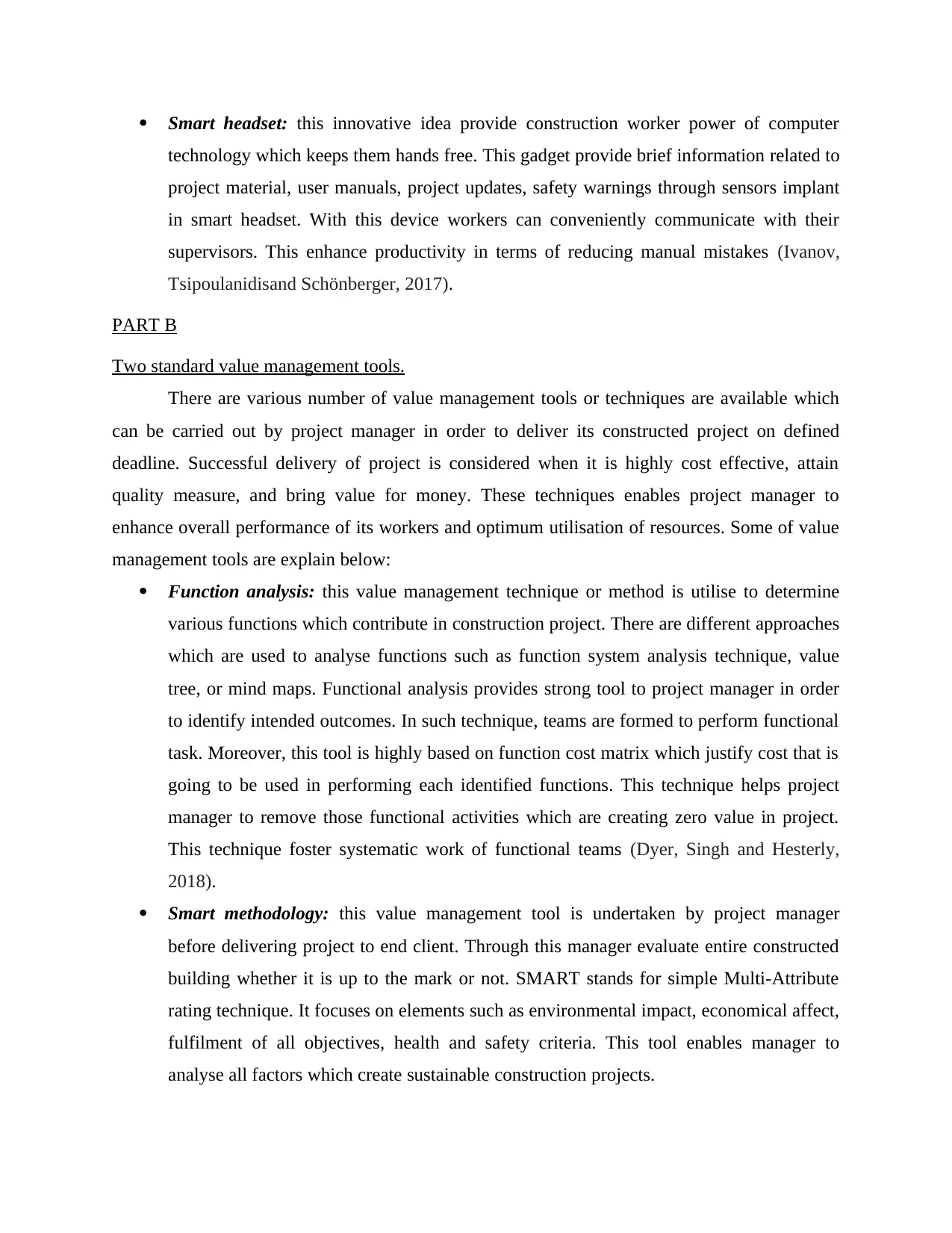
Smart headset: this innovative idea provide construction worker power of computer
technology which keeps them hands free. This gadget provide brief information related to
project material, user manuals, project updates, safety warnings through sensors implant
in smart headset. With this device workers can conveniently communicate with their
supervisors. This enhance productivity in terms of reducing manual mistakes (Ivanov,
Tsipoulanidisand Schönberger, 2017).
PART B
Two standard value management tools.
There are various number of value management tools or techniques are available which
can be carried out by project manager in order to deliver its constructed project on defined
deadline. Successful delivery of project is considered when it is highly cost effective, attain
quality measure, and bring value for money. These techniques enables project manager to
enhance overall performance of its workers and optimum utilisation of resources. Some of value
management tools are explain below:
Function analysis: this value management technique or method is utilise to determine
various functions which contribute in construction project. There are different approaches
which are used to analyse functions such as function system analysis technique, value
tree, or mind maps. Functional analysis provides strong tool to project manager in order
to identify intended outcomes. In such technique, teams are formed to perform functional
task. Moreover, this tool is highly based on function cost matrix which justify cost that is
going to be used in performing each identified functions. This technique helps project
manager to remove those functional activities which are creating zero value in project.
This technique foster systematic work of functional teams (Dyer, Singh and Hesterly,
2018).
Smart methodology: this value management tool is undertaken by project manager
before delivering project to end client. Through this manager evaluate entire constructed
building whether it is up to the mark or not. SMART stands for simple Multi-Attribute
rating technique. It focuses on elements such as environmental impact, economical affect,
fulfilment of all objectives, health and safety criteria. This tool enables manager to
analyse all factors which create sustainable construction projects.
technology which keeps them hands free. This gadget provide brief information related to
project material, user manuals, project updates, safety warnings through sensors implant
in smart headset. With this device workers can conveniently communicate with their
supervisors. This enhance productivity in terms of reducing manual mistakes (Ivanov,
Tsipoulanidisand Schönberger, 2017).
PART B
Two standard value management tools.
There are various number of value management tools or techniques are available which
can be carried out by project manager in order to deliver its constructed project on defined
deadline. Successful delivery of project is considered when it is highly cost effective, attain
quality measure, and bring value for money. These techniques enables project manager to
enhance overall performance of its workers and optimum utilisation of resources. Some of value
management tools are explain below:
Function analysis: this value management technique or method is utilise to determine
various functions which contribute in construction project. There are different approaches
which are used to analyse functions such as function system analysis technique, value
tree, or mind maps. Functional analysis provides strong tool to project manager in order
to identify intended outcomes. In such technique, teams are formed to perform functional
task. Moreover, this tool is highly based on function cost matrix which justify cost that is
going to be used in performing each identified functions. This technique helps project
manager to remove those functional activities which are creating zero value in project.
This technique foster systematic work of functional teams (Dyer, Singh and Hesterly,
2018).
Smart methodology: this value management tool is undertaken by project manager
before delivering project to end client. Through this manager evaluate entire constructed
building whether it is up to the mark or not. SMART stands for simple Multi-Attribute
rating technique. It focuses on elements such as environmental impact, economical affect,
fulfilment of all objectives, health and safety criteria. This tool enables manager to
analyse all factors which create sustainable construction projects.
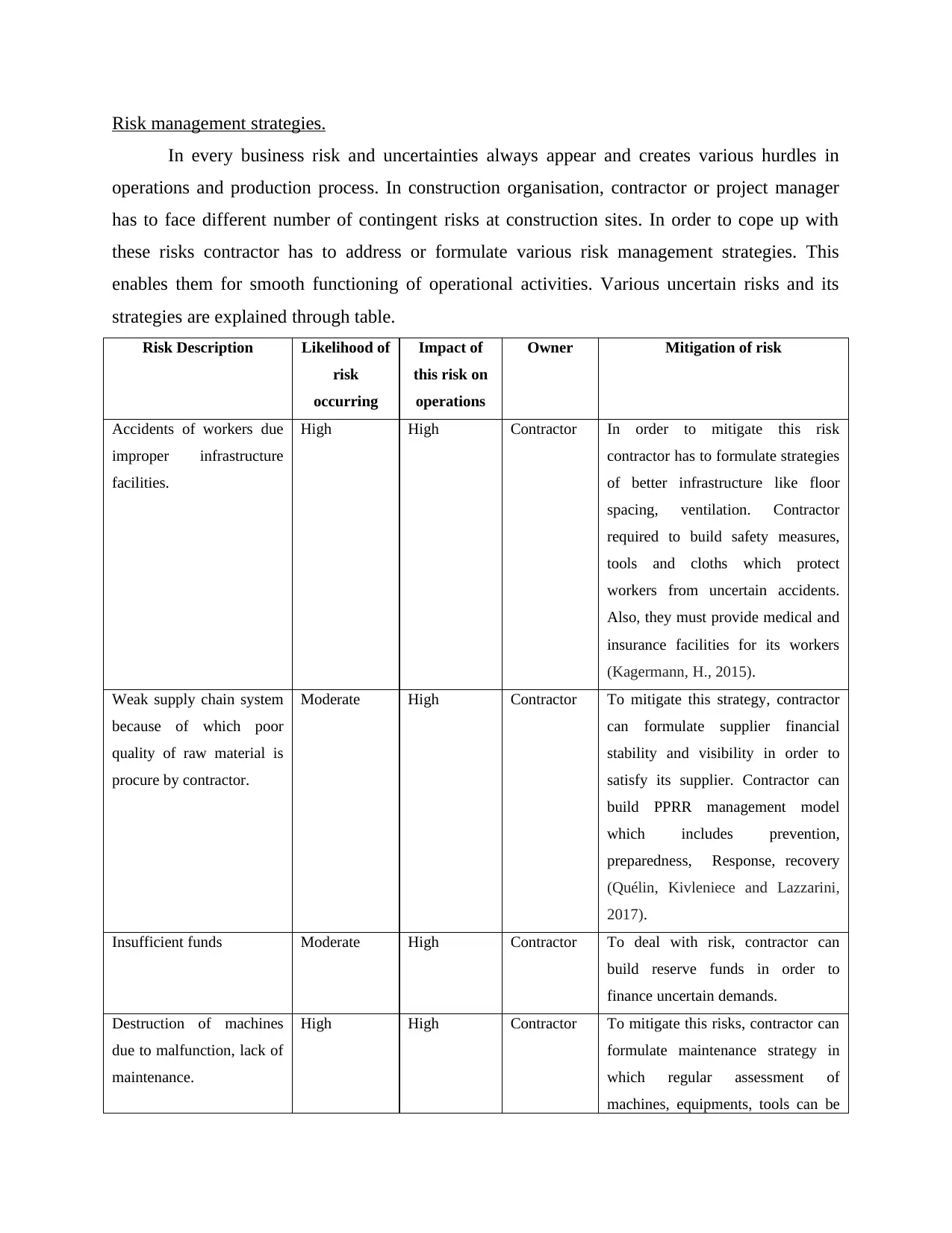
Risk management strategies.
In every business risk and uncertainties always appear and creates various hurdles in
operations and production process. In construction organisation, contractor or project manager
has to face different number of contingent risks at construction sites. In order to cope up with
these risks contractor has to address or formulate various risk management strategies. This
enables them for smooth functioning of operational activities. Various uncertain risks and its
strategies are explained through table.
Risk Description Likelihood of
risk
occurring
Impact of
this risk on
operations
Owner Mitigation of risk
Accidents of workers due
improper infrastructure
facilities.
High High Contractor In order to mitigate this risk
contractor has to formulate strategies
of better infrastructure like floor
spacing, ventilation. Contractor
required to build safety measures,
tools and cloths which protect
workers from uncertain accidents.
Also, they must provide medical and
insurance facilities for its workers
(Kagermann, H., 2015).
Weak supply chain system
because of which poor
quality of raw material is
procure by contractor.
Moderate High Contractor To mitigate this strategy, contractor
can formulate supplier financial
stability and visibility in order to
satisfy its supplier. Contractor can
build PPRR management model
which includes prevention,
preparedness, Response, recovery
(Quélin, Kivleniece and Lazzarini,
2017).
Insufficient funds Moderate High Contractor To deal with risk, contractor can
build reserve funds in order to
finance uncertain demands.
Destruction of machines
due to malfunction, lack of
maintenance.
High High Contractor To mitigate this risks, contractor can
formulate maintenance strategy in
which regular assessment of
machines, equipments, tools can be
In every business risk and uncertainties always appear and creates various hurdles in
operations and production process. In construction organisation, contractor or project manager
has to face different number of contingent risks at construction sites. In order to cope up with
these risks contractor has to address or formulate various risk management strategies. This
enables them for smooth functioning of operational activities. Various uncertain risks and its
strategies are explained through table.
Risk Description Likelihood of
risk
occurring
Impact of
this risk on
operations
Owner Mitigation of risk
Accidents of workers due
improper infrastructure
facilities.
High High Contractor In order to mitigate this risk
contractor has to formulate strategies
of better infrastructure like floor
spacing, ventilation. Contractor
required to build safety measures,
tools and cloths which protect
workers from uncertain accidents.
Also, they must provide medical and
insurance facilities for its workers
(Kagermann, H., 2015).
Weak supply chain system
because of which poor
quality of raw material is
procure by contractor.
Moderate High Contractor To mitigate this strategy, contractor
can formulate supplier financial
stability and visibility in order to
satisfy its supplier. Contractor can
build PPRR management model
which includes prevention,
preparedness, Response, recovery
(Quélin, Kivleniece and Lazzarini,
2017).
Insufficient funds Moderate High Contractor To deal with risk, contractor can
build reserve funds in order to
finance uncertain demands.
Destruction of machines
due to malfunction, lack of
maintenance.
High High Contractor To mitigate this risks, contractor can
formulate maintenance strategy in
which regular assessment of
machines, equipments, tools can be
⊘ This is a preview!⊘
Do you want full access?
Subscribe today to unlock all pages.

Trusted by 1+ million students worldwide
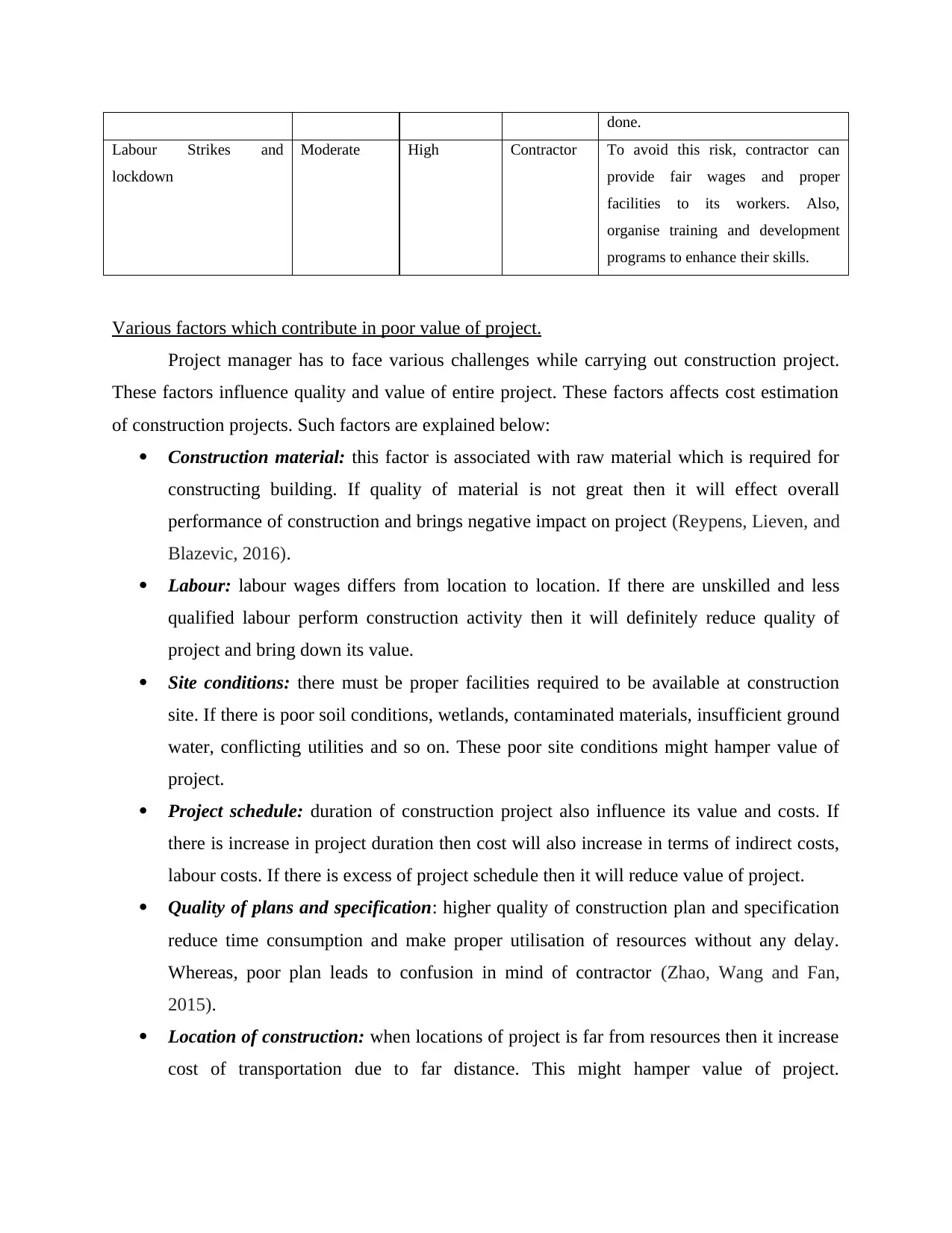
done.
Labour Strikes and
lockdown
Moderate High Contractor To avoid this risk, contractor can
provide fair wages and proper
facilities to its workers. Also,
organise training and development
programs to enhance their skills.
Various factors which contribute in poor value of project.
Project manager has to face various challenges while carrying out construction project.
These factors influence quality and value of entire project. These factors affects cost estimation
of construction projects. Such factors are explained below:
Construction material: this factor is associated with raw material which is required for
constructing building. If quality of material is not great then it will effect overall
performance of construction and brings negative impact on project (Reypens, Lieven, and
Blazevic, 2016).
Labour: labour wages differs from location to location. If there are unskilled and less
qualified labour perform construction activity then it will definitely reduce quality of
project and bring down its value.
Site conditions: there must be proper facilities required to be available at construction
site. If there is poor soil conditions, wetlands, contaminated materials, insufficient ground
water, conflicting utilities and so on. These poor site conditions might hamper value of
project.
Project schedule: duration of construction project also influence its value and costs. If
there is increase in project duration then cost will also increase in terms of indirect costs,
labour costs. If there is excess of project schedule then it will reduce value of project.
Quality of plans and specification: higher quality of construction plan and specification
reduce time consumption and make proper utilisation of resources without any delay.
Whereas, poor plan leads to confusion in mind of contractor (Zhao, Wang and Fan,
2015).
Location of construction: when locations of project is far from resources then it increase
cost of transportation due to far distance. This might hamper value of project.
Labour Strikes and
lockdown
Moderate High Contractor To avoid this risk, contractor can
provide fair wages and proper
facilities to its workers. Also,
organise training and development
programs to enhance their skills.
Various factors which contribute in poor value of project.
Project manager has to face various challenges while carrying out construction project.
These factors influence quality and value of entire project. These factors affects cost estimation
of construction projects. Such factors are explained below:
Construction material: this factor is associated with raw material which is required for
constructing building. If quality of material is not great then it will effect overall
performance of construction and brings negative impact on project (Reypens, Lieven, and
Blazevic, 2016).
Labour: labour wages differs from location to location. If there are unskilled and less
qualified labour perform construction activity then it will definitely reduce quality of
project and bring down its value.
Site conditions: there must be proper facilities required to be available at construction
site. If there is poor soil conditions, wetlands, contaminated materials, insufficient ground
water, conflicting utilities and so on. These poor site conditions might hamper value of
project.
Project schedule: duration of construction project also influence its value and costs. If
there is increase in project duration then cost will also increase in terms of indirect costs,
labour costs. If there is excess of project schedule then it will reduce value of project.
Quality of plans and specification: higher quality of construction plan and specification
reduce time consumption and make proper utilisation of resources without any delay.
Whereas, poor plan leads to confusion in mind of contractor (Zhao, Wang and Fan,
2015).
Location of construction: when locations of project is far from resources then it increase
cost of transportation due to far distance. This might hamper value of project.
Paraphrase This Document
Need a fresh take? Get an instant paraphrase of this document with our AI Paraphraser
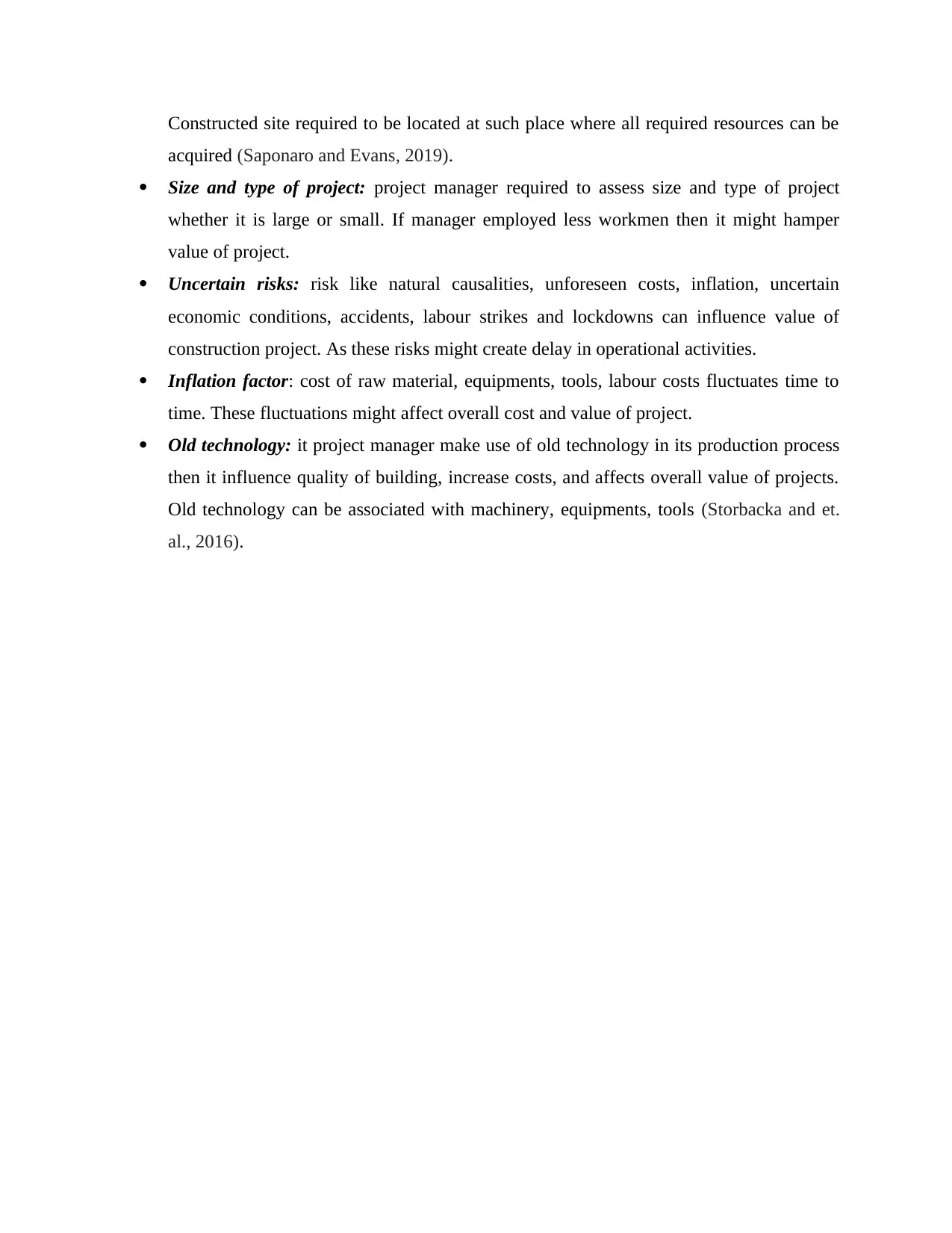
Constructed site required to be located at such place where all required resources can be
acquired (Saponaro and Evans, 2019).
Size and type of project: project manager required to assess size and type of project
whether it is large or small. If manager employed less workmen then it might hamper
value of project.
Uncertain risks: risk like natural causalities, unforeseen costs, inflation, uncertain
economic conditions, accidents, labour strikes and lockdowns can influence value of
construction project. As these risks might create delay in operational activities.
Inflation factor: cost of raw material, equipments, tools, labour costs fluctuates time to
time. These fluctuations might affect overall cost and value of project.
Old technology: it project manager make use of old technology in its production process
then it influence quality of building, increase costs, and affects overall value of projects.
Old technology can be associated with machinery, equipments, tools (Storbacka and et.
al., 2016).
acquired (Saponaro and Evans, 2019).
Size and type of project: project manager required to assess size and type of project
whether it is large or small. If manager employed less workmen then it might hamper
value of project.
Uncertain risks: risk like natural causalities, unforeseen costs, inflation, uncertain
economic conditions, accidents, labour strikes and lockdowns can influence value of
construction project. As these risks might create delay in operational activities.
Inflation factor: cost of raw material, equipments, tools, labour costs fluctuates time to
time. These fluctuations might affect overall cost and value of project.
Old technology: it project manager make use of old technology in its production process
then it influence quality of building, increase costs, and affects overall value of projects.
Old technology can be associated with machinery, equipments, tools (Storbacka and et.
al., 2016).
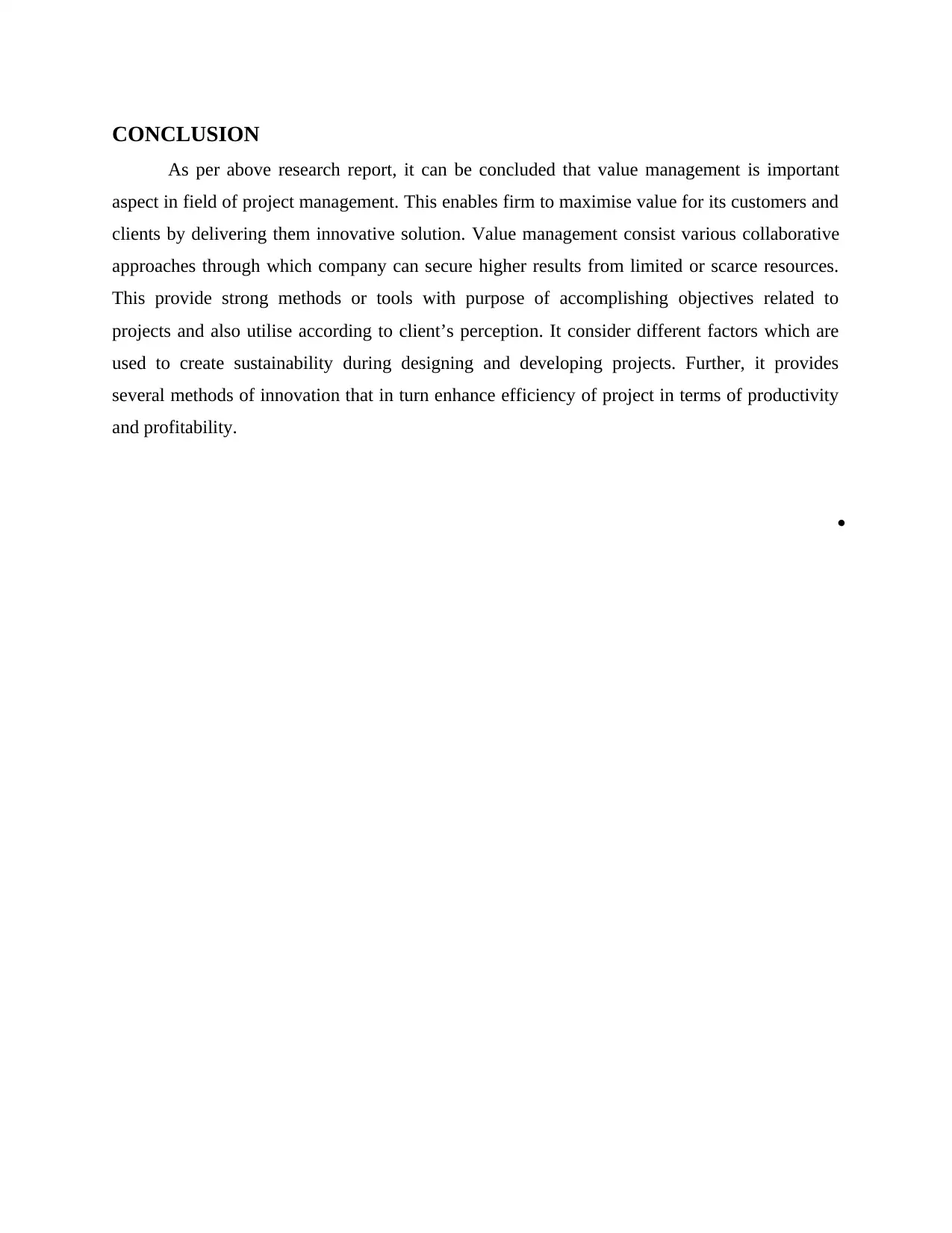
CONCLUSION
As per above research report, it can be concluded that value management is important
aspect in field of project management. This enables firm to maximise value for its customers and
clients by delivering them innovative solution. Value management consist various collaborative
approaches through which company can secure higher results from limited or scarce resources.
This provide strong methods or tools with purpose of accomplishing objectives related to
projects and also utilise according to client’s perception. It consider different factors which are
used to create sustainability during designing and developing projects. Further, it provides
several methods of innovation that in turn enhance efficiency of project in terms of productivity
and profitability.
As per above research report, it can be concluded that value management is important
aspect in field of project management. This enables firm to maximise value for its customers and
clients by delivering them innovative solution. Value management consist various collaborative
approaches through which company can secure higher results from limited or scarce resources.
This provide strong methods or tools with purpose of accomplishing objectives related to
projects and also utilise according to client’s perception. It consider different factors which are
used to create sustainability during designing and developing projects. Further, it provides
several methods of innovation that in turn enhance efficiency of project in terms of productivity
and profitability.
⊘ This is a preview!⊘
Do you want full access?
Subscribe today to unlock all pages.

Trusted by 1+ million students worldwide
1 out of 13
Related Documents
Your All-in-One AI-Powered Toolkit for Academic Success.
+13062052269
info@desklib.com
Available 24*7 on WhatsApp / Email
![[object Object]](/_next/static/media/star-bottom.7253800d.svg)
Unlock your academic potential
Copyright © 2020–2025 A2Z Services. All Rights Reserved. Developed and managed by ZUCOL.





